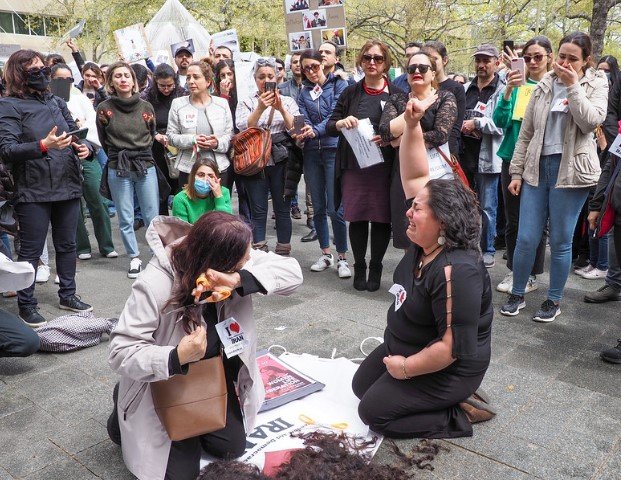In a case that has rapidly garnered international attention, a young Iranian woman protesting the country’s mandatory hijab was forcibly detained at Tehran’s Azad University after removing her clothes. The incident, captured on video, has intensified scrutiny of Iran’s response to women’s rights protests, especially as the footage of the woman—stripped to her underwear and subsequently taken into custody—has circulated widely on social media. UN Special Rapporteur on human rights in Iran, Maio Sato, announced she is closely monitoring the case, describing it as emblematic of ongoing concerns regarding the treatment of women in the country.
Sato shared the video on X (formerly Twitter), stating she would be observing the authorities’ response, which she considers a crucial moment for Iran on the global stage. This event comes in the wake of the “Women, Life, Freedom” movement that erupted following the death of Mahsa Amini in 2022 while in morality police custody—a movement that has seen repeated crackdowns by the Iranian government.
Nobel Laureate Narges Mohammadi Speaks from Prison
Narges Mohammadi, a prominent imprisoned activist and recent Nobel Peace Prize winner, released a statement from prison following the Azad University incident. Describing the young woman’s protest as a powerful “symbol of rebellion, anger, and resistance,” Mohammadi urged for her immediate release and an end to what she termed the “suppression and harassment of women.”
Her statement highlights the growing defiance of Iranian women who continue to challenge the mandatory hijab laws and other restrictive policies. “Women pay a price for their defiance,” Mohammadi said, “but they do not bow to force.” This message of resilience has resonated widely with activists and supporters, drawing attention to the sacrifices made by women in Iran who stand up for their rights.

Amnesty International Calls for Immediate Release and Safety Measures
Amnesty International has also weighed in on the incident, calling for the student’s “immediate and unconditional release” and demanding that Iranian authorities ensure her safety. Amnesty Iran posted on X, emphasizing the urgent need to protect the young woman from torture or other forms of mistreatment while in custody. The organization highlighted the importance of access to legal representation and family contact, which are often denied to detainees under similar circumstances in Iran.
The organization further called for an independent investigation into allegations of physical and sexual abuse during her arrest, a demand that underscores the broader concerns over treatment of detainees in Iran, particularly those involved in protests. “Allegations of beatings and sexual violence against her during arrest need independent and impartial investigations,” Amnesty stated, adding that all responsible parties “must be held to account.”
Conflicting Accounts and Allegations of Mental Health Issues
Following the protest, reports circulated that the student had been transferred to a psychiatric hospital, with sources attributing the decision to orders from Iran’s IRGC (Islamic Revolutionary Guard Corps) intelligence organization. Farhikhtegan, a newspaper linked with Azad University, confirmed the student’s transfer, asserting she had been admitted to a mental health facility. The publication echoed statements made by university officials, including Amir Mahjoub, the Director of Public Relations at Islamic Azad University, who attributed her protest to “severe psychological distress.”
Shortly afterward, state-affiliated media outlets released a video featuring a man identifying himself as the student’s husband. He claimed that his wife was the mother of two and suffered from mental health issues, a statement many activists believe is part of an established tactic used by the authorities to delegitimize female protestors. Online backlash quickly ensued, with social media users denouncing this as a ploy to undermine the student’s credibility and diminish the gravity of her protest.
Reignited Calls for Women’s Rights After Mahsa Amini’s Death
The latest incident is a stark reminder of the grievances that sparked the “Women, Life, Freedom” movement in the aftermath of Mahsa Amini’s death in 2022. Amini, a young woman detained by Iran’s morality police for allegedly violating hijab regulations, died in custody under circumstances widely believed to involve abuse. Her death sparked a wave of demonstrations across Iran, with men and women alike demanding greater freedoms and an end to gender-based oppression.
In recent years, women’s protests against the mandatory hijab have been met with severe state reprisals, but these demonstrations also reflect the determination of Iranian society to seek systemic change. The current case at Azad University could further galvanize calls for reform, as it highlights the lengths to which some women are willing to go in their defiance, risking arrest, abuse, and imprisonment.
With the international community, including the UN and Amnesty International, taking notice, Iran faces mounting pressure to address the grievances of its citizens, particularly those of women who are increasingly rejecting restrictive policies. As calls for the student’s release grow louder, the case may well serve as a litmus test for the government’s willingness—or reluctance—to honor fundamental rights and freedoms.
